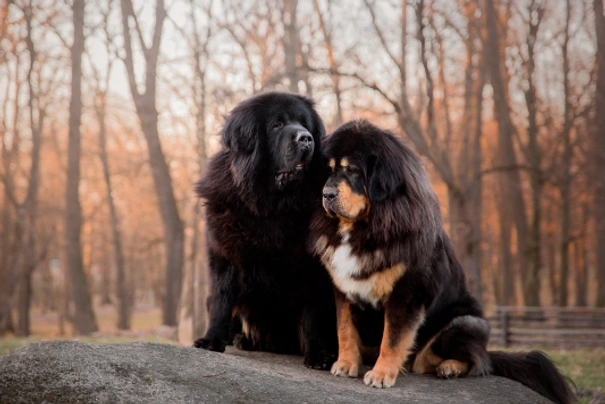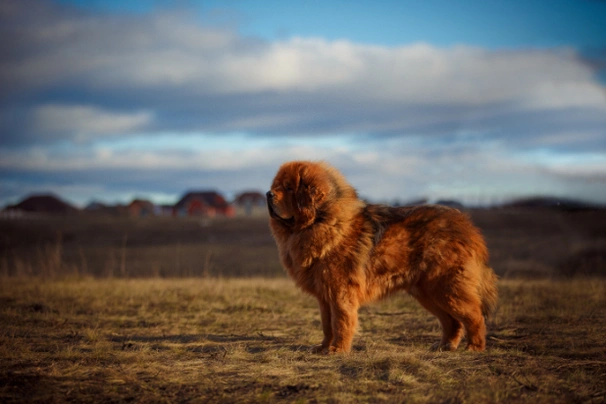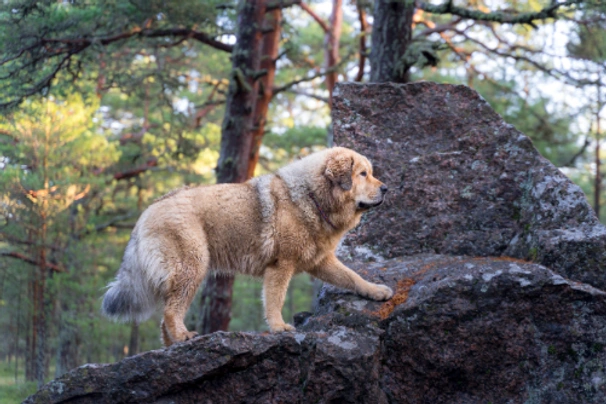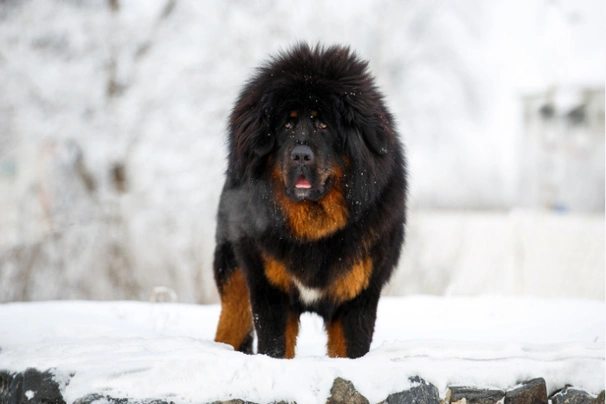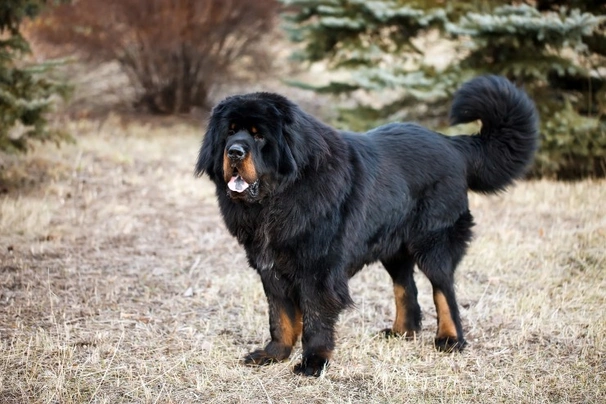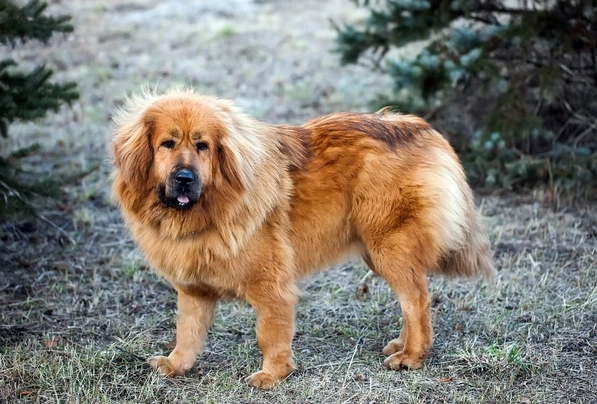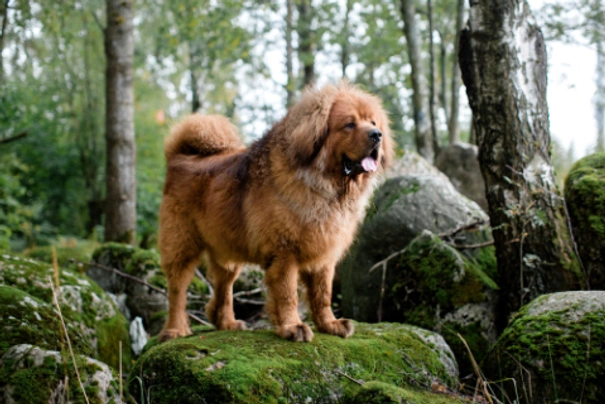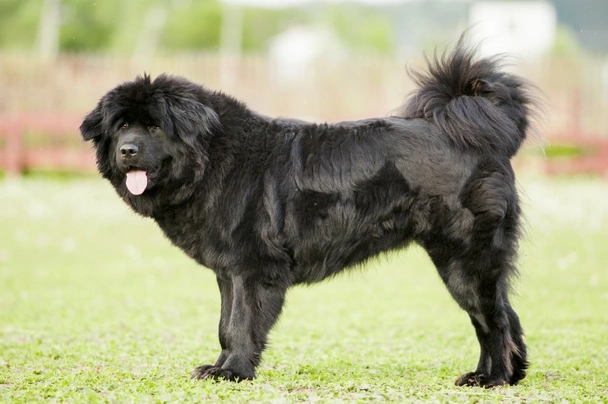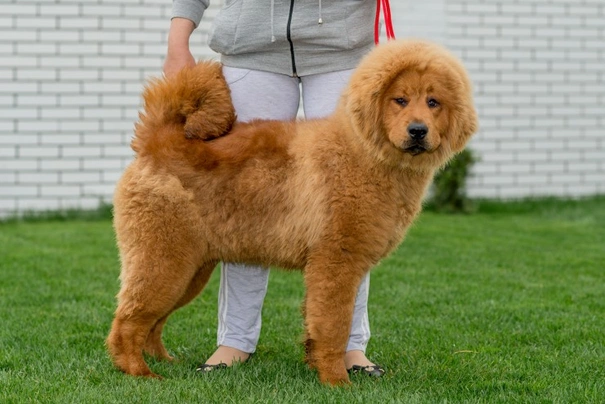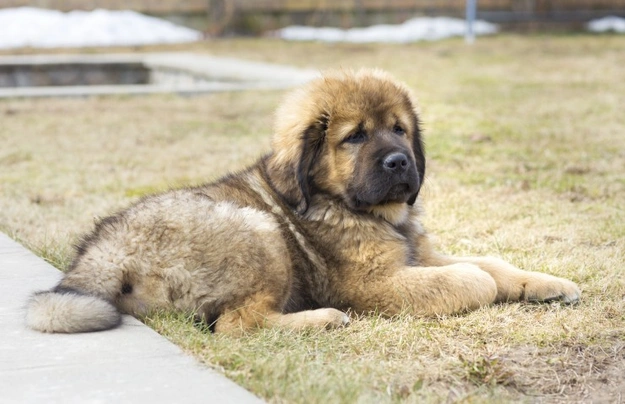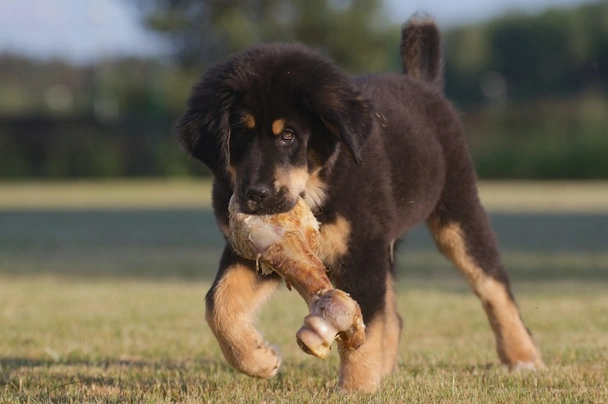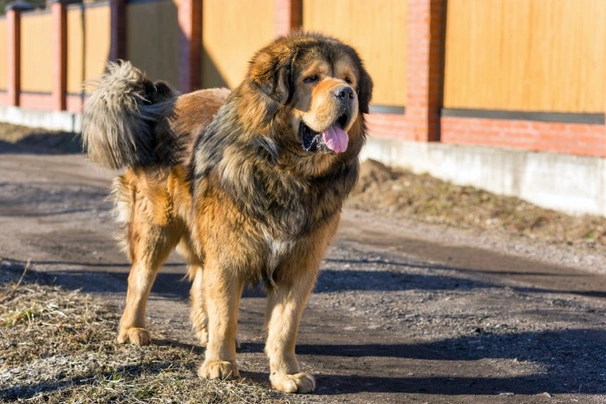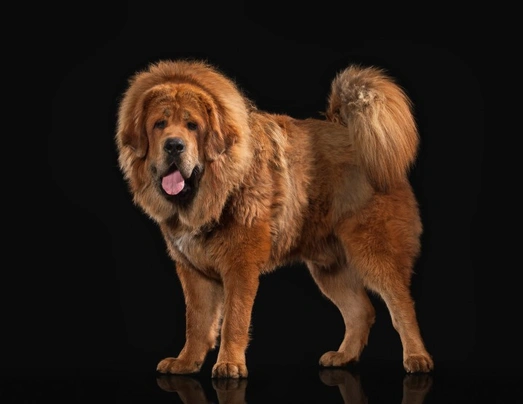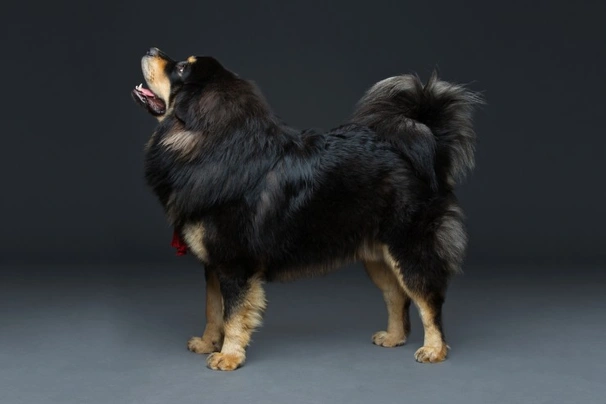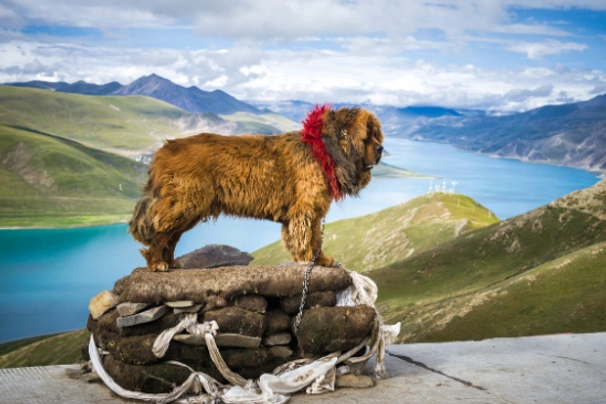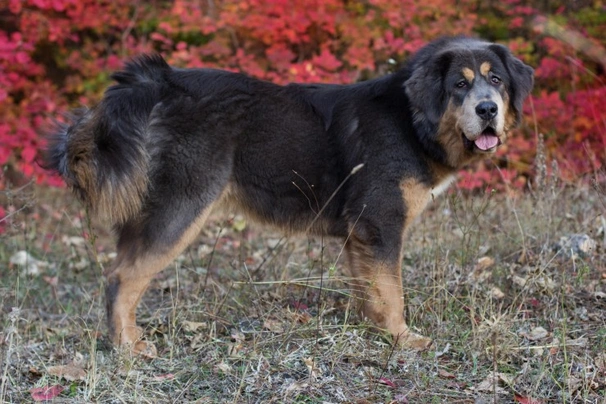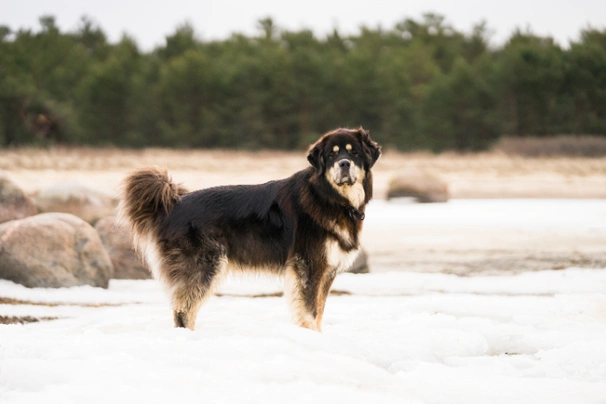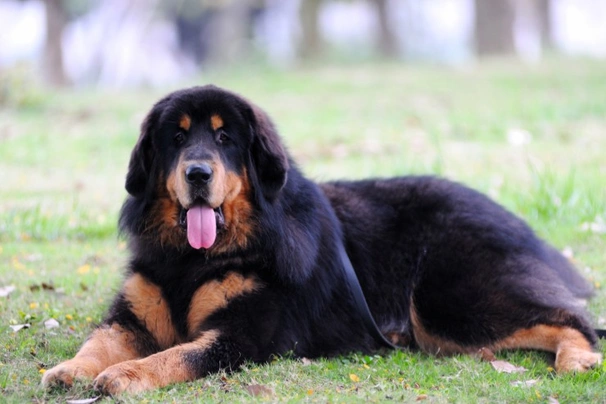Tibetan Mastiff
Pros
Cons
Introduction of the Tibetan Mastiff
Tibetan Mastiffs are impressive and noble looking dogs that boast an extremely dense double-coat and large bushy tail that dogs carry curled over their backs. They are powerful well-built and although they may seem slow and heavy Tibetan Mastiffs can show a good turn of speed when they need to. They are definitely not a good choice for first time owners because although stunning these dogs needs to be well handled and trained by someone who is familiar with the breed or similar type of dog.
For centuries these imposing dogs earned the reputation of being legendary guardians in their native Himalaya where they have always been highly prized. More recently a Tibetan Mastiff was sold for a record price making the dog the most expensive in the world. Today these noble large dogs are still quite rarely seen in the UK but the breed's popularity is gaining momentum all thanks to the fact that Tibetan Mastiffs have such kind and loyal natures.
History of the Tibetan Mastiff
Although the actual origins of the Tibetan Mastiff have been lost in the midst of time what is known is that their ancestors existed in Tibet for centuries and that they are probably descendants of the Pyrenean Mountain Dog Newfoundlandand other large dogs of this type**.** With this said the dogs we see today are very much the same as the dogs seen in ancient times as such the Tibetan Mastiff is thought to be one of the oldest purebred breeds on the planet.
In their native Tibet they are called "Do-Kyi" which translated means "Tied Dog" a reference to the fact Tibetan Mastiffs were often seen tied at the entrances of the temples tents and houses they guarded. With this said Alexander the Great was known to have several Tibetan Mastiffs which travelled with him on his expeditions which is when they started to appear in other regions of the world. Marco Polo also owned Tibetan Mastiffs and took them with him on his travels.
It was early in the 19th century that explorers came across these dogs during their expeditions into the far reaches of Tibet. A few dogs were sent back to the UK and were placed in zoos as objects of curiosity. Lord Hardinge Viceroy to India sent a Tibetan Mastiff as a gift to Queen Victoria but there are no records of the dog being used for breeding purposes.
It was not until the 1930's that a breed standard was set and the Tibetan Mastiff was officially recognised as a unique breed in its own right by The Kennel Club here in the UK. The dogs we see today outside of Tibet have been around for over a 100 years with the Prince of Wales owning one in the 1880's which also led to a rise in the breed's popularity.
Today these impressive dogs are still quite rare with not many of them being bred or puppies registered with The Kennel Club. As such anyone hoping to share their home with a Tibetan Mastiff might have to go on a waiting list if a breeder can be found that is because although a popular family pet and companion still very few well-bred Tibetan Mastiff puppies are bred and registered with the Kennel Club every year.
Interesting facts about the breed
- Is the Tibetan Mastiff a vulnerable breed? No but anyone wanting to own a TM would need to go on a waiting list because so few well-bred pedigree puppies are bred and registered with the Kennel Club every year
- A Tibetan Mastiff was sold for a record price recently making it the most expensive dog on the planet
- TMs love the cold and will play in the snow for hours
- Tibetan Mastiffs are natural watchdogs and have a tendency to go into “protect mode” at night
- They mature very slowly remaining very puppy-like right into their senior years
Appearance of the Tibetan Mastiff
Height at the withers: Males 66 cm Females 61 cm
Average weight: Males 45 - 72 kg Females 45 - 72 kg
The Tibetan Mastiff is a powerful looking dog that boasts a lot of bone. They are well-built and boast thickish long double coats with an extremely bushy tail that dog's curl over their backs. Although heavy looking the Tibetan Mastiff is very light on their feet and they are capable of showing a fast turn of speed when needed. Males have a more pronounced mane than their female counterparts.
They have broad heavy heads with a well-defined occiput and stop. Their muzzles are quite board and blunt with nice broad black noses with open nostrils. Dogs can have a little wrinkling on their heads when they mature which adds to their overall appeal. Their eyes are dark brown in colour medium in size with a very expressive look about them. They are set wide apart oval in shape slanting slightly. Eye rims are dark and tight.
Their ears are triangular pendent and moderately large hanging close to a dog's head although when they are alert dogs carry their ears a little forward. Ear leathers are well covered with lots of soft hair. Mouths are strong with dogs boasting a perfect scissor bite where their upper teeth neatly overlap their lower ones. Their neck is muscular and strong with dogs carrying them slightly arched. Shoulders are well laid back and their front legs are straight well-muscled and powerful.
Tibetan Mastiffs boast strong level backs with muscular broad loins with a slightly sloping croup. Their chests are deep and moderately broad with an oval ribcage and well sprung ribs that are carried well back. Their hindquarters are extremely muscular and powerful with dogs having strong well-muscled back legs with some dogs having double dewclaws. Feet are quite large with dogs having thick well rounded and compact paw pads and lots of feathering between each of their toes. A Tibetan Mastiff's tail is one of the breed's defining features being wonderfully feathered and curling over a dog's back and typically to one side.
When it comes to their coat the Tibetan Mastiff boast fairly long thick double coat with the undercoat being heavy and woolly. The top coat is finer and straight with the hair on a dog's face being shorter than on the rest of their body. The hair on their neck and shoulders is longer and thicker which creates their mane. Tails and the upper parts of their back legs are very well feathered. Acceptable colours include the following:
- Black
- Black & Tan
- Gold
- Grey
- Grey & Gold
- Grey & Tan
Marking above a dog's eyes on their muzzles chests lower part of their legs and underside of their tail are a very rich colour. Dogs can have a white star on their chests and spectacles around their eyes. Some white on their feet is also acceptable.
Gait/movement
When a Tibetan Mastiff moves they do so with a free and powerful gait always with tremendous agility and purpose. When a TM walks they do so with a deliberate gait but when on the move their front and back legs single track.
Faults
The Kennel Club frowns on any exaggerations or departures from the breed standard and would judge the faults on how much they affect a dog's overall health and wellbeing as well as their ability to perform.
Males should have both testicles fully descended into their scrotums and it is worth noting that a dog can be a little lighter or heavier as well as slightly taller or shorter than set out in the Kennel Club breed standard which is given as a guideline only.
Temperament of the Tibetan Mastiff
The Tibetan Mastiff is a large imposing and impressive dog and one that needs to be well socialised as a puppy and then trained by an experienced person from an early age for them to be truly well-rounded dogs. As such they are not the best choice for first time owners**.**
They are known to be fiercely loyal protective thoughtful quiet and calm. A Tibetan Mastiff is also very protective of their families and homes. They need to be handled firmly but always fairly so they understand their place in the "pack" and who is alpha dog in a household. These dogs are never happier than when they get all the direction and guidance they need from their leader. If a Tibetan Mastiff does not get the right sort of guidance they will start to show a more dominant side to their natures which often results them becoming unruly and wilful.
They respond very well to positive reinforcement training and dislike any sort of harsh correction. For such large dogs they are very capable of showing remarkable affection and gentleness when treated with the respect that they deserve but they are not necessarily suited to families with children especially younger children and toddlers. With this said the Tibetan Mastiff loves to be part of a family and to be involved in everything that goes on in the home. They are known to form very strong bonds with their owners but can be wary around strangers although they would rarely show any sort of aggressive behaviour towards people they don't know unless they feel threatened.
Are they a good choice for first time owners?
Tibetan Mastiffs are not the best choice for first time dog owners because they need to be handled and trained by people who are familiar with the needs of such large dogs which could easily get the better of a novice owner.
What about prey drive?
TMs have a high prey drive and as such should not be trusted off the lead when out on a walk near livestock or wild animals bearing in mind that they are tremendously strong and they can be quite stubborn when the mood takes them. As such they would happily turn a deaf ear to the recall command if they spot something more interesting in the distance.
What about playfulness?
Tibetan Mastiffs have a very playful side to their natures and love to be involved in interactive games. However puppies must be taught to play "nicely" and it's best to teach them that playtime is outside and not inside a house to avoid breakages around the home.
What about adaptability?
TM are very large dogs and as such they need enough space to express themselves as they should. They are not suited to apartment living but do very well if they can roam around a secure back garden whenever they can to really let off steam bearing in mind the fencing must be extremely robust to keep dogs in.
What about separation anxiety?
Although Tibetan Mastiffs form strong ties with their families they do not mind being left on their own providing it is never for too long. In short the breed is not known to suffer from separation anxiety but any dog that's left alone for extended periods of time might be destructive around the home and could bark incessantly to get some attention bearing in mind that TMs are known for the bouts of "barking" from time to time anyway.
What about excessive barking?
As previously mentioned Tibetan Mastiffs are known for their uncontrollable bouts of barking which many owners can never fathom. With this said they don't typically bark for the sake of it and will usually only voice their opinions when they think their need to get their owners attention.
Do Tibetan Mastiffs like water?
Tibetan Mastiffs are not known to be "water dogs" although some enjoy taking a dip when the weather is hot. However if anyone who owns a dog that does not like water should never force them to go in because it would just end up scaring them. With this said care should always be taken when walking a TM off the lead anywhere near more dangerous watercourses just in case a dog decides to leap in and then needs rescuing because they cannot get out of the water on their own. It is also important for dogs to be thoroughly dried off when they get wet to avoid a skin issue from flaring up.
Are Tibetan Mastiffs good watchdogs?
TMs are natural watchdogs and the need to "protect" is a trait that's deeply embedded in a dog's psyche. They do not need to be trained to protect which could end up making a dog more aggressive and dominant which leads to them being harder to manage and handle.
Intelligence / Trainability of the Tibetan Mastiff
The Tibetan Mastiff is known to be an intelligent dog but their training must be consistent right from the word go. They do boast a bit of a stubborn streak in them and will show a more dominant side to their nature if they are not correctly handled and trained when they are young.
It's also essential for puppies to be well socialised from a young age which means introducing them to new people situations and other animals as soon as they have been fully vaccinated for them to mature into well-rounded dogs. TM puppies are very cute but they grow up to be impressive strong large adult dogs all too quickly. As such new owners need to start out as they mean to go on by laying out ground rules so that a puppy understands what is expected of them. The first commands a puppy should be taught are as follows:
- Come
- Sit
- Stay
- Quiet
- Leave it
- Down
- Bed
Children and other
Tibetan Mastiffs are not the best choice for people with young families because not only are they extremely large dogs but they boast a natural instinct to guard. However if well socialised they are a good choice for people with older children who would know how to behave around such a large dog. With this said any interaction between children and dogs should always be supervised by an adult to make sure things don’t get too boisterous which could end up with a child being knocked over albeit by accident.
Care needs to be taken when a Tibetan Mastiff first meets any new animals but if they have grown up with other pets in a household they will generally tolerate them being around. If a dog has been well socialised from a young age and met lots of other dogs they are usually alright around them but some TMs will still try to be the dominant dog so care must be taken when they meet any new dogs.
Health of the Tibetan Mastiff
The average life expectancy of a Tibetan Mastiff is between 9 and 15 years when properly cared for and fed an appropriate good quality diet to suit their ages.
Like so many other breeds the Tibetan Mastiff is known to suffer from a few hereditary health issues which are worth knowing about if you are planning share your home with one of these active and impressive looking dogs. The conditions that seem to affect the breed the most include the following:
- Hip dysplasia - dogs should be hip scored
- Elbow dysplasia - dogs should be DNA tested
- Eye issues - dogs should be tested
- Thyroid deficiencies
- Skin allergies
- Bloat/gastric torsion
It is worth noting that bitches typically only have one season a year which is usually in the autumn.
What about vaccinations?
TM puppies would have been given their initial vaccinations before being sold but it is up to their new owners to make sure they have their follow-up shots in a timely manner with the vaccination schedule for puppies being as follows:
- 10 -12 weeks old bearing in mind that a puppy would not have full protection straight away but would be fully protected 2 weeks after they have had their second vaccination
There has been a lot of discussion about the need for dogs to have boosters. As such it's best to talk to a vet before making a final decision on whether a dog should continue to have annual vaccinations which are known as boosters.
What about spaying and neutering?
A lot of vets these days recommend waiting until dogs are slightly older before spaying and neutering them which means they are more mature before undergoing the procedures. As such they advise neutering males and spaying females when they are between the ages of 6 to 9 months old and sometimes even when a dog is 12 months old.
Other vets recommend spaying and neutering dogs when they are 6 months old but never any earlier unless for medical reasons. With this said many breeds are different and it is always advisable to discuss things with a vet and then follow their advice on when a dog should be spayed or neutered.
What about obesity problems?
Some Tibetan Mastiffs gain weight after they have been spayed or neutered and it's important to keep an eye on a dog's waistline just in case they do. If a dog starts to put on weight it's important to adjust their daily calorie intake and to up the amount of exercise they are given. Older dogs too are more prone to gaining weight and again it's essential they be fed and exercised accordingly because obesity can shorten a dog's life by several years. The reason being that it puts a lot of extra strain on a dog's internal organs including the heart which could prove fatal.
What about allergies?
Tibetan Mastiffs are prone to suffering from allergies and it's important for a dog to see a vet sooner rather than later if one flares up which is why their coats must be thoroughly dried off whenever they get wet. Allergies can be notoriously hard to clear up and finding the triggers can be challenging. With this said a vet would be able to make a dog with an allergy more comfortable while they try to find out the triggers which could include the following:
- Certain dog foods that contain high levels of grains and other cereal fillers
- Airborne pollens
- Dust mites
- Environment
- Flea and tick bites
- Chemicals found in everyday household cleaning products
Participating in health schemes
All responsible Tibetan Mastiff breeders would ensure that their stud dogs are tested for known hereditary and congenital health issues known to affect the breed by using the following schemes:
What about breed specific breeding restrictions?
Apart from the standard breeding restrictions that are set in place by the Kennel Club for all registered breeds there are no other breed specific breeding restrictions for the Tibetan Mastiff.
What about Assured Breeder Requirements?
It is mandatory for all KC Assured Breeders to use the following scheme and the Kennel Club strongly recommends that all other breeders follow suit:
The Kennel Club strongly advises all breeders to use the following scheme on their stud dogs:
Caring for the Tibetan Mastiff
As with any other breed Tibetan Mastiffs need to be groomed on a regular basis to make sure their coats and skin are kept in top condition. They also need to be given regular daily exercise to ensure they remain fit and healthy. On top of this dogs need to be fed good quality food that meets all their nutritional needs throughout their lives.
Caring for a Tibetan Mastiff puppy
TM puppies are boisterous and full of life which means it's essential for homes and gardens to be puppy-proofed well in advance of their arrival. A responsible breeder would have well socialised their puppies which always leads to more outgoing confident and friendly dogs right from the word go. With this said any puppy is going to feel vulnerable when they leave their mother and littermates which must be taken into account. The longer a puppy can remain with their mother the better although it should never be for too long either.
It's best to pick a puppy up when people are going to be around for the first week or so which is the time needed for a puppy to settle in. Puppy-proofing the home and garden means putting away any tools and other implements that a boisterous puppy might injure themselves on. Electric wires and cables must be put out of their reach because puppies love chewing on things. Toxic plants should be removed from flowerbeds and the home too.
Puppies need to sleep a lot to grow and develop as they should which means setting up a quiet area that's not too out of the way means they can retreat to it when they want to nap and it's important not to disturb them when they are sleeping. It's also a good idea to keep "playtime" nice and calm inside the house and to have a more active "playtime" outside in the garden which means puppies quickly learn to be less boisterous when they are inside.
The documentation a breeder provides for a puppy must have all the details of their worming date and the product used as well as the information relating to their microchip. It is essential for puppies to be wormed again keeping to a schedule which is as follows:
- Puppies should be wormed at 6 months old
- They need to be wormed again when they are 8 months old
- Puppies should be wormed when they are 10 months old
- They need to be wormed when they are 12 months old
Things you'll need for your puppy
There are certain items that new owners need to already have in the home prior to bringing a new puppy home. It's often a good idea to restrict how much space a puppy plays in more especially when you can't keep an eye on what they get up to bearing in mind that puppies are often quite boisterous which means investing in puppy gates or a large enough playpen that allows a puppy the room to express themselves while keeping them safe too. The items needed are therefore as follows:
- Good quality puppy or baby gates to fit on doors
- A good well-made playpen that's large enough for a puppy to play in so they can really express themselves as puppies like to do
- Lots of well-made toys which must include good quality chews suitable for puppies to gnaw on bearing in mind that a puppy will start teething anything from when they are 3 to 8 months old
- Good quality feed and water bowls which ideally should be ceramic rather than plastic or metal
- A grooming glove
- A slicker brush or soft bristle brush
- Dog specific toothpaste and a toothbrush
- Scissors with rounded ends
- Nail clippers
- Puppy shampoo and conditioner which must be specifically formulated for use on dogs
- A well-made dog collar or harness
- A couple of strong dog leads
- A well-made dog bed that's not too small or too big
- A well-made dog crate for use in the car and in the home that's large enough for a puppy to move around in
- Baby blankets to put in your puppy's crate and in their beds for when they want to nap or go to sleep at night
Keeping the noise down
All puppies are sensitive to noise including Tibetan Mastiff puppies. It's important to keep the noise levels down when a new puppy arrives in the home. TVs and music should not be played too loud which could end up stressing a small puppy out.
Keeping vet appointments
As previously mentioned Tibetan Mastiff puppies would have been given their first vaccinations by the breeders but they must have their follow up shots which is up to their new owners to organise. The vaccination schedule for puppies is as follows:
- 10 -12 weeks old bearing in mind that a puppy would not have full protection straight away but would only be fully protected 2 weeks after they have had their second vaccination
When it comes to boosters it's best to discuss these with a vet because there is a lot of debate about whether a dog really needs them after a certain time. However if a dog ever needed to go into kennels their vaccinations would need to be fully up to date.
What about older Tibetan Mastiffs when they reach their senior years?
Older Tibetan Mastiffs need lots of special care because as they reach their golden years they are more at risk of developing certain health concerns. Physically a dog's muzzle may start to go grey but there will be other noticeable changes too which includes the following:
- Coats become coarser
- A loss of muscle tone
- TMs can either become overweight or underweight
- They have reduced strength and stamina
- Older dogs have difficulty regulating their body temperature
- They often develop arthritis
- Immune systems do not work as efficiently as they once did which means dogs are more susceptible to infections
Older dogs change mentally too which means their response time tends to be slower as such they develop the following:
- They respond less to external stimuli due to impaired vision or hearing
- They tend to be a little pickier about their food
- They have a lower pain threshold
- Become intolerant of any change
- Often an older dog can feel disorientated
Living with a Tibetan Mastiff in their golden years means taking on a few more responsibilities but these are easily managed and should include taking a look at their diet the amount of exercise they are given how often their dog beds need changing and keeping an eye on the condition of their teeth.
Older TMs need to be fed a good quality diet that meets their needs at this stage of their lives all the while keeping a close eye on a dog's weight. A rough feeding guide for older dogs is as follows bearing in mind they should be fed highly digestible food that does not contain any additives:
- Protein content should be anything from 14 – 21%
- Fat content should be less than 10%
- Fibre content should be less than 4%
- Calcium content should be 0.5 – 0.8%
- Phosphorous content should be 0.4 – 0.7%
- Sodium content should be 0.2 – 0.4%
Older TMs don't need to be given the same amount of daily exercise as a younger dog but they still need the right amount of physical activity to maintain muscle tone and to prevent a dog from putting on too much weight. All dogs need access to fresh clean water and this is especially true of older dogs when they reach their golden years because they are more at risk of developing kidney disorders.
Grooming of the Tibetan Mastiff
The Tibetan Mastiff boasts having a thick double coat with the hair around their necks being quite a bit longer than on the rest of their body which gives these dogs their lion-like looks. Although their coats are quite heavy it is not that hard to keep these dogs looking tidy because they are not prone to matting. A twice weekly brush would be enough to take out any dead or loose hair and keep things tidy.
Unlike many other breeds the Tibetan Mastiff loses their coat once a year between the months of April and July when more frequent brushing would be necessary. It's at this time of the year that dogs blow their undercoat and it comes out in large lumps. However they do not shed constantly throughout the year like other Mastiff-types and dogs.
It's important to check their ears on a regular basis and to clean them when necessary. If too much wax builds up in a dog's ears it provides the perfect environment for an infection to flare up which can be very hard to treat.
Exercise of the Tibetan Mastiff
Tibetan Mastiffs need to be given at least an hour's exercise every day and they also need to be given a lot of mental stimulation for them to be truly happy well-rounded characters. However because they have such thick dense coats it's important not to over-exercise them when the weather is hot because these dogs feel the heat and are prone to overheat extremely quickly. It's best to take them out first thing in the morning for a short walk and then again late in the afternoon when the sun is lower in the sky and the temperature is cooler.
Young Tibetan Mastiff puppies should not be given too much exercise because their joints and bones are still growing and too much pressure on them could result in causing a dog a few problems later in their lives.
Feeding of the Tibetan Mastiff
If you get a Tibetan Mastiff puppy from a breeder they would give you a feeding schedule and it's important to stick to the same routine feeding the same puppy food to avoid any tummy upsets. You can change a puppy's diet but this needs to be done very gradually always making sure they don't develop any digestive upsets and if they do it's best to put them back on their original diet and to discuss things with the vet before attempting to change it again.
Some adolescent dogs can be a little fussy about their food but it is important to persevere and not to spoil them which could make it harder to find a suitable diet they would eat as adult mature dogs. It's also important to keep an eye on the protein levels in a Tibetan Mastiff's diet which should not be anything above 20 - 22%.
Older dogs are not known to be fussy or finicky eaters but this does not mean you can feed them a lower quality diet. It's best to feed a mature dog twice a day once in the morning and then again in the evening making sure it's good quality food that meets all their nutritional requirements. It's also important that dogs be given the right amount of exercise so they burn off any excess calories or they might gain too much weight which can lead to all sorts of health issues. Obesity can shorten a dog's life by several years so it's important to keep an eye on their waistline from the word go.
Because they are prone to suffer from bloat it is really important that they be fed twice a day instead of giving them just one larger meal a day. It's also a good idea to invest in a stand to place their feed bowl which makes it easier for these large dogs to eat comfortably without having to stretch their necks down low to reach their food. You should never feed a Tibetan Mastiff just before or just after they have eaten either because this puts them more a risk of suffering from bloat.
Feeding guide for a Tibetan Mastiff puppy
Puppies need to be fed a highly nutritious good quality diet for them to develop and grow as they should. As a rough guide a TM puppy can be fed the following amounts every day making sure their meals are evenly spread out throughout the day and it's best to feed them 3 or 4 times a day:
- 2 months old - 309g to 429g depending on puppy's build
- 3 months old - 406g to 570g depending on puppy's build
- 4 months old - 449g to 637g depending on puppy's build
- 5 months old - 534g to 761g depending on puppy's build
- 6 months old - 607g to 869g depending on puppy's build
- 7 months old - 609g to 882g depending on puppy's build
- 8 months old - 605g to 884g depending on puppy's build
- 9 months old - 557g to 868g depending on puppy's build
- 10 months old - 521g to 818g depending on puppy's build
- 11 months old - 476g to 764g depending on puppy's build
- 12 months old - 434g to 711g depending on puppy's build
- 13 months old - 431g to 667g depending on puppy's build
- 14 months old - 426g to 626g depending on puppy's build
Once a puppy is 18 months old they can be fed adult dog food.
Feeding guide for an adult Tibetan Mastiff
Once fully mature an adult Tibetan Mastiff must be fed a good quality diet to ensure their continued good health. As a rough guide an adult TM can be fed the following amounts every day:
- Dogs weighing 45 kg can be fed 394g to 519g depending on activity
- Dogs weighing 55 kg can be fed 458g to 603g depending on activity
- Dogs weighing 65 kg can be fed 519g to 683g depending on activity
- Dogs weighing 72 kg can be fed 578g to 761g depending on activity
Tibetan Mastiff price
If you are looking to buy a Tibetan you may have trouble finding a breeder and if you do you may well have to accept being put on a waiting list and you should expect to pay over £1000 for a pedigree puppy. The cost of insuring a male 3-year-old Tibetan Mastiff in northern England would be £59.31 a month for basic cover but for a lifetime policy this would set you back £112.65 a month (quote as of February 2018). When insurance companies calculate a pet's premium they factor in several things which includes where you live in the UK and a dog's age and whether they have been neutered or spayed.
When it comes to food costs you need to buy the best quality food whether wet or dry to feed your dog throughout their lives making sure it suits the different stages of their lives. This would set you back between £60 - £70 a month. On top of this you would need to factor in veterinary costs if you want to share your home with a Tibetan Mastiff and this includes their initial vaccinations their annual boosters the cost of neutering or spaying your dog when the time is right and their yearly health checks all of which quickly adds up to over a £1500 a year.
As a rough guide the average cost to keep and care for a Tibetan Mastiff would be between £130 to £200 a month depending on the level of insurance cover you opt to buy for your dog but this does not include the initial cost of buying a healthy well-bred Kennel Club registered pedigree Tibetan Mastiff puppy.
Buying advice
When visiting and buying any puppy or dog there are many important things to consider and questions to ask of the breeder/seller. You can read our generic puppy/dog advice here which includes making sure you see the puppy with its mother and to verify that the dog has been wormed and microchipped.
Tibetan Mastiffs are a popular breed both in the UK and elsewhere in the world which means that well-bred puppies can often command a lot of money bearing in mind that very few puppies are bred every year. As such with Tibetan Mastiffs there is specific advice questions and protocols to follow when buying a puppy which are as follows:
- Beware of online scams and how to avoid them. You may see online and other adverts by scammers showing images of beautiful Tibetan Mastiffpuppies for sale at very low prices. However the sellers ask buyers for money up front before agreeing to deliver a puppy to a new home. Potential buyers should never buy a puppy unseen and should never pay a deposit or any other money online to a seller. You should always visit the pet at the sellers home to confirm they are genuine and make a note of their address.
- As previously touched upon Tibetan Mastiffs are popular in the UK. As such there are many amateur breeders/people who breed from a dam far too often so they can make a quick profit without caring for the welfare of the puppies their dam or the breed in general. Under Kennel Club rules a dam can only produce 4 litters and she must be between a certain age to do so. Anyone wishing to buy a TM puppy should think very carefully about who they purchase their puppy from and should always ask to see the relevant paperwork pertaining to a puppy's lineage their vaccinations and their microchipping.

Ready now - Exceptional Tibetan Mastiff Puppies
£1,750
Female pedigree Tibetan mastiff for rehoming
£800
